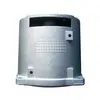Mobile:+86-311-808-126-83
Email:info@ydcastings.com
Understanding the Factors Contributing to Impeller Wear in Pumping Systems and Their Impacts
Impeller Wearing Causes, Effects, and Mitigation Strategies
Impellers are crucial components in various mechanical systems, particularly in pumps, turbines, and reactors. Their primary function is to transfer energy to fluids, facilitating movement and enhancing efficiency. However, like many mechanical components, impellers are susceptible to wear over time. Impeller wearing is an essential topic that merits attention due to its implications on system performance, maintenance costs, and operational safety.
Causes of Impeller Wearing
Impeller wear can be attributed to several factors. The most common causes include erosion, corrosion, and fatigue. Erosion occurs when particles or abrasive materials in the fluid impact the impeller surfaces, gradually wearing them down. This type of wear is particularly prevalent in slurry pumps or systems that handle abrasive materials. Corrosion, on the other hand, is the result of chemical reactions between the impeller material and the fluid, especially in environments involving corrosive chemicals or extreme pH levels. Finally, fatigue wear develops over time due to repeated mechanical stresses, which can lead to micro-cracking and eventual component failure.
The material of the impeller plays a significant role in its susceptibility to wear. For instance, impellers made of softer metals or plastics may wear faster than those constructed from more robust materials such as stainless steel or high-strength alloys. Additionally, improper installation or misalignment can exacerbate wear by imposing uneven loads on the impeller, leading to premature failure.
Effects of Impeller Wearing
The consequences of impeller wear can be profound. One of the most immediate effects is a decline in efficiency. As the impeller wears down, its ability to generate flow and pressure diminishes, leading to increased energy consumption and reduced system performance. This inefficiency often translates into higher operational costs, as systems may need to run longer or work harder to achieve the desired output.
impeller wearing

Furthermore, worn impellers can lead to imbalanced forces within the system, which may cause vibrations and noise, compromising the reliability of the entire system. In severe cases, excessive wear can result in catastrophic failure, requiring costly repairs or complete replacements, thus extending downtime and impacting productivity.
Mitigation Strategies
To combat the challenges posed by impeller wear, several strategies can be implemented. Firstly, selecting the right material is crucial. Companies should opt for materials that are specifically designed to withstand the conditions of their operational environment. For example, using hard-facing techniques or coatings can protect impellers from erosion and corrosion.
Regular maintenance and inspections are also critical in identifying wear patterns early on. Implementing predictive maintenance strategies, such as vibration analysis and performance monitoring, allows for timely intervention before wear leads to failure. Additionally, proper training for personnel can ensure that systems are operated within their design parameters, minimizing the likelihood of misalignment and other issues that can hasten wear.
Finally, advancements in technology offer new avenues for managing impeller wear. The use of computer simulations and modeling can help in understanding wear mechanisms, enabling better design and selection of impellers for specific applications. Moreover, the adoption of smart sensors can facilitate real-time monitoring, providing vital data that can inform maintenance decisions.
Conclusion
Impeller wearing is an inevitable phenomenon in mechanical systems that can significantly impact performance and maintenance costs. By understanding the causes and effects of wear, as well as implementing effective mitigation strategies, operators can enhance the longevity and efficiency of impellers. Investing in the right materials, conducting regular maintenance, and embracing technological advancements are key steps in managing impeller wear effectively, ensuring optimal operation and reliability for years to come.
-
Why Should You Invest in Superior Pump Castings for Your Equipment?NewsJun.09,2025
-
Unlock Performance Potential with Stainless Impellers and Aluminum End CapsNewsJun.09,2025
-
Revolutionize Your Machinery with Superior Cast Iron and Aluminum ComponentsNewsJun.09,2025
-
Revolutionize Fluid Dynamics with Premium Pump ComponentsNewsJun.09,2025
-
Optimizing Industrial Systems with Essential Valve ComponentsNewsJun.09,2025
-
Elevate Grid Efficiency with High-Precision Power CastingsNewsJun.09,2025











